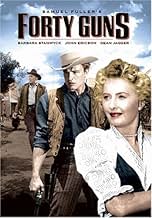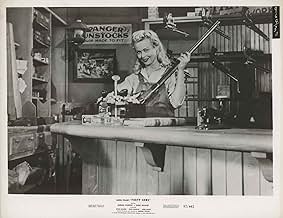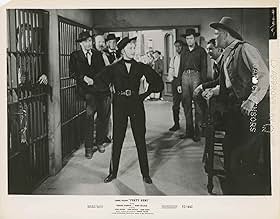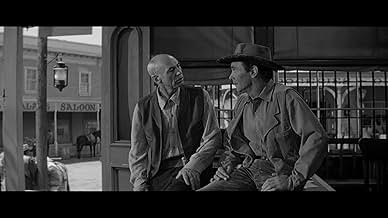AVALIAÇÃO DA IMDb
6,9/10
6,8 mil
SUA AVALIAÇÃO
Adicionar um enredo no seu idiomaShowdown in Arizona between the Bonell brothers - U.S. Marshals - and Jessica Drummond, the iron-fisted rancher who controls the territory.Showdown in Arizona between the Bonell brothers - U.S. Marshals - and Jessica Drummond, the iron-fisted rancher who controls the territory.Showdown in Arizona between the Bonell brothers - U.S. Marshals - and Jessica Drummond, the iron-fisted rancher who controls the territory.
Sandy Wirth
- Chico's Girlfriend
- (as Sandra Wirth)
Albert Cavens
- Doctor
- (não creditado)
Tex Driscoll
- Barber
- (não creditado)
Avaliações em destaque
Sam Fuller actually made a good number of westerns in his early career, and thanks to DVD we are finally able to see these at home just in these past few years. I can't say how long I was looking for "Baron of Arizona." Pleased to say that this one is just as ambitious and fulfilling as the other two that I've seen, "Baron" and "I Shot Jesse James." Barbara Stanwyck is welcome in ANY western film as far as I'm concerned, and Barry Sullivan's "long walk" is the most stylish you'll ever see. Dean Jagger provides his usual characterization of a conflicted and compromised noble man.
Fuller centers the film around a few key scenes, specific confrontations that define the rest of the action surrounding them. His sense of style in terms of the characters and their interactions with their surroundings is impressive. For instance the scene with the man who's supposed to trick Griff into an ambush -- we really get to know that character and sense his fear just in a short time. I love how he and his actors make use of accidents and physical limitations of the sets. For instance there's a bit where Sullivan is running towards the action and a tumbleweed comes across his path, and he leaps across it in a really stylish way. In some circumstances that could have become a ruined take, but Fuller obviously has his actor so much into the spirit of the scene that he basically reacts in character. You can sense Fuller's ability to focus his actors that way hanging over both the action and dialog scenes.
I'd have to see the film again to really say much about its theme or its subject, but it seems to be in the classic mold of westerns about the end of the "Old West." Stanwyck and Sullivan represent different types of iconic western presence that will depart from the world forever with that ending.
The conclusion of the film is a bit underwhelming, but other than that I really have no complaints about this film. It's fine western entertainment from the closing days of the western about the closing days of the west.
Fuller centers the film around a few key scenes, specific confrontations that define the rest of the action surrounding them. His sense of style in terms of the characters and their interactions with their surroundings is impressive. For instance the scene with the man who's supposed to trick Griff into an ambush -- we really get to know that character and sense his fear just in a short time. I love how he and his actors make use of accidents and physical limitations of the sets. For instance there's a bit where Sullivan is running towards the action and a tumbleweed comes across his path, and he leaps across it in a really stylish way. In some circumstances that could have become a ruined take, but Fuller obviously has his actor so much into the spirit of the scene that he basically reacts in character. You can sense Fuller's ability to focus his actors that way hanging over both the action and dialog scenes.
I'd have to see the film again to really say much about its theme or its subject, but it seems to be in the classic mold of westerns about the end of the "Old West." Stanwyck and Sullivan represent different types of iconic western presence that will depart from the world forever with that ending.
The conclusion of the film is a bit underwhelming, but other than that I really have no complaints about this film. It's fine western entertainment from the closing days of the western about the closing days of the west.
Barbara Stanwyck (hard as nails) plays a powerful rancher with political ties near Tombstone whose hired hands, mostly crooked and lead by her own brother, bring her together with Barry Sullivan of the U.S. Attorney General's office, out to arrest one of her boys for robbery. Surprisingly brutal and adult western from Globe Enterprises and distributed by Twentieth Century-Fox, written and directed by Samuel Fuller as if he were trying to find a place for every western cliché in the filmmaker's manual. Joseph Biroc's moody black-and-white cinematography gives the proceedings an intensity that elevates the script, even as Fuller's staging--particularly the gun-blazing confrontations--typically run the gamut from florid to outrageous. Sullivan is sturdy (and colorless) as usual; Stanwyck has this type of role down pat. **1/2 from ****
If you've never seen this film, I think you'll find it a bit different from most classic westerns. It's really more of a film noir, I thought, and I liked that angle. I say "film noir" because of feel. This western had stark black-and-white photography with tons of shadows and it had a dramatic scene near the end that was very noir-ish. I was very impressed with the ending, and that's all I will say as to not spoil it for others.
The DVD has the option of fullscreen or widescreen. Please consider the latter, because that is how it was presented: in "cinemascope," and you'll want to see photographer Joseph Birac's work in all its glory.
For Barbara Stanwyck fans, this might be a little disappointing because Barry Sullivan is the star of the film, not her, despite the billing. Sullivan plays "Griff Bonnell" and he is the principal figure in the movie, although Stanwyck's presence and character in the story are very strong as "Jessica Drummond." "Griff," along with his brothers, played by Gene Barry and Robert Dix, have more lines than Stanwyck, who doesn't even come on screen until 20 of the 80 minutes have elapsed.
All the characters are pretty interesting, however, no matter what their screen time. Those include some strange supporting roles, particularly two lawmen who don't sound and act like lawmen: Hank Worden's marshal role in the beginning and Dean Jagger's stint as the sheriff who has designs on Stanwyck.
To repeat, this is an odd story. I mean, how often does one see a tornado in the middle of a western movie? Some of the lines in here were quite profound, too, and some were uttered really stupidly. It's a curiosity piece, that's for sure.....but definitely worth watching if good photography and odd characters interest you.
The DVD has the option of fullscreen or widescreen. Please consider the latter, because that is how it was presented: in "cinemascope," and you'll want to see photographer Joseph Birac's work in all its glory.
For Barbara Stanwyck fans, this might be a little disappointing because Barry Sullivan is the star of the film, not her, despite the billing. Sullivan plays "Griff Bonnell" and he is the principal figure in the movie, although Stanwyck's presence and character in the story are very strong as "Jessica Drummond." "Griff," along with his brothers, played by Gene Barry and Robert Dix, have more lines than Stanwyck, who doesn't even come on screen until 20 of the 80 minutes have elapsed.
All the characters are pretty interesting, however, no matter what their screen time. Those include some strange supporting roles, particularly two lawmen who don't sound and act like lawmen: Hank Worden's marshal role in the beginning and Dean Jagger's stint as the sheriff who has designs on Stanwyck.
To repeat, this is an odd story. I mean, how often does one see a tornado in the middle of a western movie? Some of the lines in here were quite profound, too, and some were uttered really stupidly. It's a curiosity piece, that's for sure.....but definitely worth watching if good photography and odd characters interest you.
This is the only one I've watched from a handful of Westerns Fuller made - and it's just as individualistic as any of his War films! Despite the presence of an A-list star in Barbara Stanwyck (past her prime but still extraordinary), at a mere 80 minutes, the film was pretty much considered a second-feature - which isn't necessarily a bad thing, since this very compactness allows it greater focus on the themes inherent in Fuller's script (which are pretty much treated like high melodrama in the rampant style of Anthony Mann's THE FURIES [1950], also with Stanwyck, and Nicholas Ray's JOHNNY GUITAR [1954])!
Still, the rest of cast is equally impressive - especially Barry Sullivan (though never quite achieving stardom, he's suitably imposing here as the ageing but steadfast hero and matches Stanwyck every step of the way), Dean Jagger (in a role vaguely similar to the one he played in BAD DAY AT BLACK ROCK [1955], but with even fewer redeeming qualities) and John Ericson (also from BLACK ROCK, but in a completely different role as Stanwyck's hot-headed younger brother). There's also crooner Jidge Carroll on hand (in his one-and-only film) who, apart from performing two tolerable ballads, acts as a sort of Chorus to the proceedings!
Besides, the film features a number of effective scenes (an ambush, a hurricane, a matter-of-factly-presented suicide and a remarkable final shoot-out) - which are made even more memorable by Joseph Biroc's superlative 'Scope photography.
Still, the rest of cast is equally impressive - especially Barry Sullivan (though never quite achieving stardom, he's suitably imposing here as the ageing but steadfast hero and matches Stanwyck every step of the way), Dean Jagger (in a role vaguely similar to the one he played in BAD DAY AT BLACK ROCK [1955], but with even fewer redeeming qualities) and John Ericson (also from BLACK ROCK, but in a completely different role as Stanwyck's hot-headed younger brother). There's also crooner Jidge Carroll on hand (in his one-and-only film) who, apart from performing two tolerable ballads, acts as a sort of Chorus to the proceedings!
Besides, the film features a number of effective scenes (an ambush, a hurricane, a matter-of-factly-presented suicide and a remarkable final shoot-out) - which are made even more memorable by Joseph Biroc's superlative 'Scope photography.
Forty Guns (1957)
Sam Fuller's style is uncompromising and over the top. He pushes both melodrama and visual drama. And he's also extremely astute handling the actors and the space and light they move through. His movies are definitely experiences, from "The Naked Kiss" to "The Big Red One" all the way back to the masterpiece, "Pickup on South Street."
And he usually tells a strong clear story. That's the big weakness here. It's as if all the over-sized elements, including Barbara Stanwyck as this unlikely woman power queen frontier figure with forty men at her beck and call, are juggled around enough to keep it interesting just on their own. Not only will the progress of events be sometimes confusing, it will at times also be too unlikely to hold water, which is even worse.
Not that the movie isn't a thrill to watch. I mean watch, with your eyes. The sparkling widescreen photography is so good, so very good and original, you can't help but like that part of it. In a way that's sustaining--it's what kept me glued. But that's my thing. I'm a photographer. I love the physical structure of movies. This movie was made for me. It's made to be studied.
And that's what "Forty Guns" is famous for, an over-sized influence. The French writers of the time (like Godard) and some later American upstarts (like Tarantino) have praised the filmmaking, if not always the film. You can certainly see, and appreciate, how much a movie like this foreshadowed the spaghetti westerns which have become so famous, but which were made six and more years later.
And that's worth remembering, too. Westerns, as a genre, are well worn by now. The themes have been worked and overworked. To make a new fresh western means pushing it to some limit, and for Fuller that means a soap opera exaggeration. That means galloping horses endlessly around a waiting stagecoach as the horses jump in fear. That means a man walking up to his rival and walking and walking, far longer than it would take to cover the hundred yards shown, until reaching him and punching, not shooting him. It means a final glorious scene that is shown farther and farther in the distance and all you see are two little dots as figures--and yet you know what just happened, and how satisfying that is.
And how unreasonable the events were getting us to that point. "Forty Guns" plays loose with archetypes in a pre-post-modern way that has made it weirdly contemporary. Fuller's films, like his unlikely contemporary Douglas Sirk's, have taken on a life of their own, as flawed as they are. This may not be the best place to start to love his work, but it's a good place to start to understand where movies had gotten to--some would say fallen--by the late 1950s. Check it out.
Sam Fuller's style is uncompromising and over the top. He pushes both melodrama and visual drama. And he's also extremely astute handling the actors and the space and light they move through. His movies are definitely experiences, from "The Naked Kiss" to "The Big Red One" all the way back to the masterpiece, "Pickup on South Street."
And he usually tells a strong clear story. That's the big weakness here. It's as if all the over-sized elements, including Barbara Stanwyck as this unlikely woman power queen frontier figure with forty men at her beck and call, are juggled around enough to keep it interesting just on their own. Not only will the progress of events be sometimes confusing, it will at times also be too unlikely to hold water, which is even worse.
Not that the movie isn't a thrill to watch. I mean watch, with your eyes. The sparkling widescreen photography is so good, so very good and original, you can't help but like that part of it. In a way that's sustaining--it's what kept me glued. But that's my thing. I'm a photographer. I love the physical structure of movies. This movie was made for me. It's made to be studied.
And that's what "Forty Guns" is famous for, an over-sized influence. The French writers of the time (like Godard) and some later American upstarts (like Tarantino) have praised the filmmaking, if not always the film. You can certainly see, and appreciate, how much a movie like this foreshadowed the spaghetti westerns which have become so famous, but which were made six and more years later.
And that's worth remembering, too. Westerns, as a genre, are well worn by now. The themes have been worked and overworked. To make a new fresh western means pushing it to some limit, and for Fuller that means a soap opera exaggeration. That means galloping horses endlessly around a waiting stagecoach as the horses jump in fear. That means a man walking up to his rival and walking and walking, far longer than it would take to cover the hundred yards shown, until reaching him and punching, not shooting him. It means a final glorious scene that is shown farther and farther in the distance and all you see are two little dots as figures--and yet you know what just happened, and how satisfying that is.
And how unreasonable the events were getting us to that point. "Forty Guns" plays loose with archetypes in a pre-post-modern way that has made it weirdly contemporary. Fuller's films, like his unlikely contemporary Douglas Sirk's, have taken on a life of their own, as flawed as they are. This may not be the best place to start to love his work, but it's a good place to start to understand where movies had gotten to--some would say fallen--by the late 1950s. Check it out.
Você sabia?
- CuriosidadesBarbara Stanwyck's stunt woman refused to be dragged by a horse, saying that it was too dangerous. Without further ado, Stanwyck did it by herself. She got some bruises and scrapes, but was okay. At that time, she was 49 years old.
- Erros de gravaçãoWhen the gunsmith is fitting Wes for a new rifle, he is holding the stock from a model 1898 Mauser, which would not be invented for another 20 years. Wes also picks up a Winchester and looks through the barrel to see the lady gunsmith, which is not possible due to there being no straight line of sight through the action.
- Citações
Jessica Drummond: I'm not interested in *you*, Mr. Bonnell. It's your trademark.
[gestures at his gun, purring]
Jessica Drummond: May I feel it?
Griff Bonnell: Uh-uh.
Jessica Drummond: Just curious.
Griff Bonnell: It might go off in your face.
Jessica Drummond: I'll take a chance.
- ConexõesEdited into Gli ultimi giorni dell'umanità (2022)
Principais escolhas
Faça login para avaliar e ver a lista de recomendações personalizadas
- How long is Forty Guns?Fornecido pela Alexa
Detalhes
- Data de lançamento
- País de origem
- Idioma
- Também conhecido como
- Forty Guns
- Locações de filme
- Empresas de produção
- Consulte mais créditos da empresa na IMDbPro
Bilheteria
- Orçamento
- US$ 300.000 (estimativa)
- Faturamento bruto mundial
- US$ 6.344
- Tempo de duração1 hora 20 minutos
- Cor
- Proporção
- 2.35 : 1
Contribua para esta página
Sugerir uma alteração ou adicionar conteúdo ausente

Principal brecha
By what name was Dragões da Violência (1957) officially released in India in English?
Responda



































